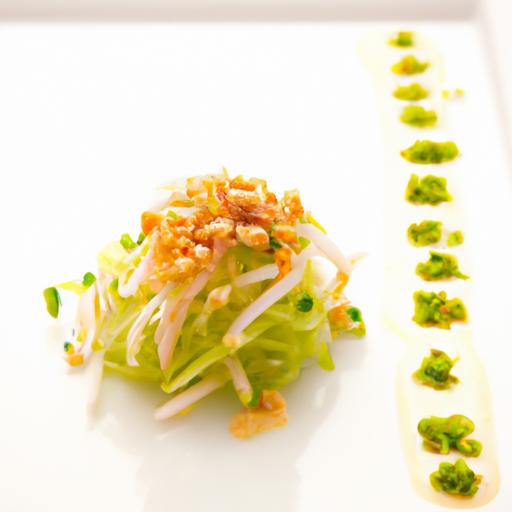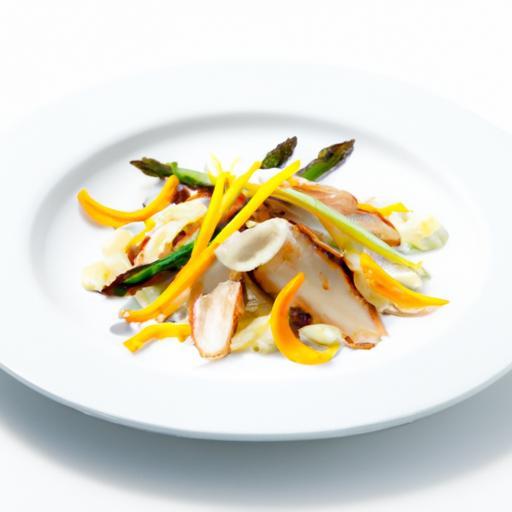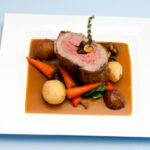Imagine biting into a sizzling hot slice of pizza, its melted cheese stretching with every pull, the steam rising like a fragrant mist-then contrast that with the same pizza chilled, its flavors muted yet intriguingly different, colder textures unveiling hidden notes. Temperature is more than just a physical state; it’s an invisible chef, subtly shaping how we perceive taste. From the fiery kick of a freshly brewed espresso to the crisp refreshment of an icy sorbet, the way heat and cold dance across our taste buds transforms flavor in surprising ways. In this article, we’ll explore the fascinating science behind how temperature unlocks and reshapes the sensory experience of our favorite foods, proving that when it comes to flavor, temperature truly is the secret ingredient.
The Science Behind Temperature and Taste Interaction
Taste on Fire or Ice: How Temperature Shapes Flavor Perception offers a fascinating journey into how temperature manipulates the way we experience food. When heat meets your dish, it doesn’t just cook the ingredients-it unlocks and intensifies invisible aromatic compounds while elevating natural sweetness. Conversely, chilling a bite mutes bitterness and transforms texture, delivering an entirely new sensory profile that can refresh or soothe the palate.
How Heat Amplifies Aromas and Sweetness in Foods
Warmth speeds up the evaporation of volatile aroma molecules, sending inviting scents directly to your olfactory receptors. That caramelized crust on roasted vegetables or seared steak? It’s the Maillard reaction releasing layers of complex, savory-nutty flavors that are heightened by heat. Simultaneously, heat enhances the perception of sweetness by softening starches and breaking down complex sugars, making desserts like warm apple crumble irresistible. This temperature-flavor synergy encourages us to savor every fragrant, sweet note.
Chilling Effects on Bitterness and Texture Perception
Cold temperatures, on the other hand, suppress bitterness-think of how iced coffee tastes smoother than hot brewed. Chilling also affects texture by firming up fats and proteins, giving creamy desserts or crisp salads a satisfying bite. When served cold, bitterness is less pronounced and sweetness is subdued, resulting in a more balanced and refreshing experience. This principle is why chefs often serve rich sauces slightly chilled or add chilled components to contrast warm dishes.
Practical Tips for Serving Food and Drinks at Optimal Temperatures
- Warm dishes: Serve hearty stews, grilled meats, and roasted vegetables hot to release their full aromatics and deepen sweetness.
- Cold preparations: Offer salads, ceviches, and chilled desserts well-chilled to highlight crisp textures and soften harsh flavors.
- Wine and beverages: Serve white wines and rosés chilled between 45-55°F to enhance their fruity bouquet, while reds shine best at 60-65°F to unlock vibrant aromas without dullness.
- Balance warm and cold: Pairing hot and cold elements on a plate can enhance contrast and complexity, such as warm crab cakes with a chilled lemon aioli.
Prep and Cook Time
Prep: 10 minutes | Cook: 20 minutes
Yield
Serves 4
Difficulty Level
Medium
Ingredients
- 2 cups roasted carrots, warm, cut into bite-sized pieces
- 1 cup crisp green apple, chilled and diced
- 1/4 cup toasted walnuts, roughly chopped
- 3 tbsp honey, warmed
- 2 tbsp fresh lemon juice, chilled
- 1 tsp ground cinnamon
- Salt and black pepper, to taste
- Fresh mint leaves, for garnish
Instructions
- Preheat oven to 400°F (200°C). Toss the carrots with a pinch of salt, pepper, and half the honey. Spread on a baking sheet and roast for 20 minutes until tender and slightly caramelized.
- While carrots roast, dice the green apple and toss with chilled lemon juice to maintain crispness and prevent browning.
- In a small bowl, mix the remaining honey with cinnamon for an aromatic drizzle.
- Once carrots are warm from the oven, combine with the chilled apple in a serving bowl.
- Sprinkle toasted walnuts over the mix and drizzle the warm honey-cinnamon blend over the top. Toss gently.
- Garnish with fresh mint leaves to add a cool herbal contrast against the warmth.
- Serve immediately to enjoy the harmony of temperatures enhancing both texture and flavor.
Chef’s Notes
- For a vegan version, replace honey with maple syrup warmed gently to preserve sweetness.
- Try swapping walnuts for pecans or pistachios for different textural layers.
- To amplify the temperature contrast, chill the serving bowl beforehand.
- If you prefer a spicier kick, add a pinch of ground ginger with cinnamon in your drizzle.
- This dish can be prepared partially ahead by roasting carrots and refrigerating apples separately; combine just before serving.
Serving Suggestions
Plate this dish alongside a warm protein like grilled chicken or serve it as a refreshing side at your next dinner party. Garnish further with microgreens or a light crumble of feta to introduce creamy saltiness that balances the honeyed sweetness and crisp chill of apple. Paired with a chilled glass of aromatic white wine, this dish offers a delightful sensory play between “fire and ice.”
| Nutrition | Per Serving |
|---|---|
| Calories | 180 kcal |
| Protein | 3 g |
| Carbohydrates | 26 g |
| Fat | 8 g |
Discover more on how aroma influences taste and expand your culinary skills. For detailed scientific insights into how temperature changes flavor, visit NRC Research.

Q&A
Q&A: Taste on Fire or Ice – How Temperature Shapes Flavor Perception
Q1: Can the temperature of food or drink actually change its flavor?
Absolutely! Temperature plays a starring role in how we perceive taste. Heat can amplify sweetness and aroma, making warm dishes feel richer and more comforting. On the flip side, cold temperatures often suppress sweetness but enhance crispness and reduce bitterness, giving a refreshing twist.
Q2: Why does ice cream taste different when it’s melting versus straight from the freezer?
When ice cream is rock-solid, cold numbs some taste buds and dampens sweetness. As it melts and warms, sweetness and creamy flavors bloom – your tongue senses more nuances. It’s like a flavor symphony gradually reaching its crescendo as the temperature rises.
Q3: How does temperature influence bitterness?
Bitterness tends to stand out more when food is cold. That’s why iced coffee or chilled green tea can taste more intense and sometimes sharper compared to their hot counterparts. Warmer temperatures can soften bitterness, balancing out flavors for a smoother sip.
Q4: Is there a science behind why warm soup tastes more comforting?
Yes! Heat awakens volatile aroma compounds, sending more fragrance molecules into the air, which your nose eagerly detects. Because flavor is a dance between taste and smell, warmer soup feels more flavorful and thus, comforting.
Q5: Do people’s taste preferences change with temperature variations?
Definitely. On chilly days, we gravitate towards warm, hearty flavors with enhanced sweetness and richness, while hot summer months often spark cravings for chilled, crisp, and less sweet treats. Temperature nudges our palate and mood alike.
Q6: Can temperature affect how spicy food feels?
It sure can! Warm foods can amplify the burn of spices, making heat hit harder. Conversely, cold dishes or drinks can dull the sting, offering a cooling comfort that tames fiery sensations.
Q7: How can chefs use temperature to elevate a dish?
Chefs mastermind temperature to balance flavors and textures-serving a salad chilled to preserve crunch, or a sauce warm to boost aroma. Thoughtful temperature contrast adds excitement, guiding our taste buds on a dynamic journey.
Q8: Is the concept of “taste on fire or ice” universal across cultures?
While the basic principles of temperature and taste interplay are universal, cultural preferences shape how the balance is struck. Some cultures embrace hot, spicy dishes year-round, while others prize chilled delicacies. Temperature can tell a flavorful cultural story.
Q9: What’s a simple way for home cooks to experiment with temperature and flavor?
Try tasting the same ingredient at different temperatures-like sipping warm versus iced herbal tea, or having fresh fruit straight from the fridge versus room temperature. Notice how your perception shifts, and you’ll uncover new dimensions to everyday flavors.
Q10: Why does bubbly soda taste fizzier when it’s cold?
Cold temperatures keep carbon dioxide dissolved longer, so your soda retains its fizz and bites more sharply on the tongue. Warm soda loses fizz faster, feeling flat and less lively.
Temperature is not just a background player-it’s a dynamic force sculpting every mouthful. Whether fiery hot or refreshingly cold, your palate’s adventure starts with the heat of the moment!
The Conclusion
As we close this exploration into the fiery sparks and icy whispers of taste, it becomes clear that temperature is more than a mere backdrop to our culinary experiences-it is a dynamic architect of flavor perception. Whether it’s the bold intensity unleashed by heat or the subtle clarity preserved in the cold, temperature dances with taste buds to craft sensations that are as complex as they are unforgettable. So next time you savor a steaming dish or a chilled delicacy, remember: you’re not just tasting ingredients-you’re witnessing the transformative power of temperature, turning every bite into a vibrant story of flavor.


